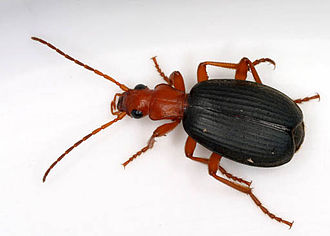Difference between revisions of "AY Honors/Insect/Coleoptera/es"
From Pathfinder Wiki
< AY HonorsAY Honors/Insect/Coleoptera/es
(Created page with "Category:Adventist Youth Honors Answer Book/es <noinclude>") |
(Created page with "Species id/es |common_name = Escarabajos |latin_name = Coleoptera |order = Coleoptera |image = Brachinus spPCCA20060328-2821B.jpg |description = Los escarabajos son un grupo d...") |
||
| Line 3: | Line 3: | ||
{{ | {{ | ||
| − | Species id | + | Species id/es |
| − | |common_name = | + | |common_name = Escarabajos |
|latin_name = Coleoptera | |latin_name = Coleoptera | ||
|order = Coleoptera | |order = Coleoptera | ||
|image = Brachinus spPCCA20060328-2821B.jpg | |image = Brachinus spPCCA20060328-2821B.jpg | ||
|description = | |description = | ||
| − | + | Los escarabajos son un grupo de insectos que tienen el mayor número de especies. Se colocan en el orden Coleoptera, que significa «ala enfundada» y contiene más especies descritas que en cualquier otro orden en el reino animal, constituyendo aproximadamente el veinticinco por ciento de todas las formas de vida conocidas. El cuarenta por ciento de todas las especies de insectos descritas son escarabajos (alrededor de 350.000 especies) y con frecuencia se descubren nuevas especies. Las estimaciones sitúan el número total de especies, descritas y no descritas, entre 5 y 8 millones. | |
Beetles can be found in almost all habitats, but are not known to occur in the sea or in the polar regions. They interact with their ecosystems in several ways. They often feed on plants and fungi, break down animal and plant debris, and eat other invertebrates. Some species are prey of various animals including birds and mammals. Certain species are agricultural pests, such as the Colorado potato beetle Leptinotarsa decemlineata, the boll weevil Anthonomus grandis, the red flour beetle Tribolium castaneum, and the mungbean or cowpea beetle Callosobruchus maculatus, while other species of beetles are important controls of agricultural pests. For example, coccinellidae ("ladybirds" or "ladybugs") consume aphids, scale insects, thrips, and other plant-sucking insects that damage crops. | Beetles can be found in almost all habitats, but are not known to occur in the sea or in the polar regions. They interact with their ecosystems in several ways. They often feed on plants and fungi, break down animal and plant debris, and eat other invertebrates. Some species are prey of various animals including birds and mammals. Certain species are agricultural pests, such as the Colorado potato beetle Leptinotarsa decemlineata, the boll weevil Anthonomus grandis, the red flour beetle Tribolium castaneum, and the mungbean or cowpea beetle Callosobruchus maculatus, while other species of beetles are important controls of agricultural pests. For example, coccinellidae ("ladybirds" or "ladybugs") consume aphids, scale insects, thrips, and other plant-sucking insects that damage crops. | ||
Revision as of 21:17, 16 January 2019
| Coleoptera (Escarabajos) | |
|---|---|
|
Orden: Coleoptera
Descripción: Los escarabajos son un grupo de insectos que tienen el mayor número de especies. Se colocan en el orden Coleoptera, que significa «ala enfundada» y contiene más especies descritas que en cualquier otro orden en el reino animal, constituyendo aproximadamente el veinticinco por ciento de todas las formas de vida conocidas. El cuarenta por ciento de todas las especies de insectos descritas son escarabajos (alrededor de 350.000 especies) y con frecuencia se descubren nuevas especies. Las estimaciones sitúan el número total de especies, descritas y no descritas, entre 5 y 8 millones.
Beetles can be found in almost all habitats, but are not known to occur in the sea or in the polar regions. They interact with their ecosystems in several ways. They often feed on plants and fungi, break down animal and plant debris, and eat other invertebrates. Some species are prey of various animals including birds and mammals. Certain species are agricultural pests, such as the Colorado potato beetle Leptinotarsa decemlineata, the boll weevil Anthonomus grandis, the red flour beetle Tribolium castaneum, and the mungbean or cowpea beetle Callosobruchus maculatus, while other species of beetles are important controls of agricultural pests. For example, coccinellidae ("ladybirds" or "ladybugs") consume aphids, scale insects, thrips, and other plant-sucking insects that damage crops.
|
Coleoptera
|

